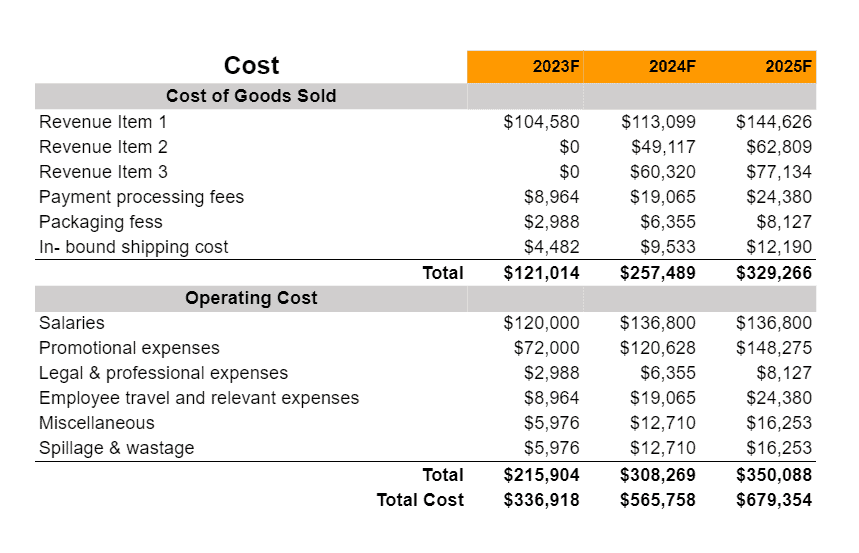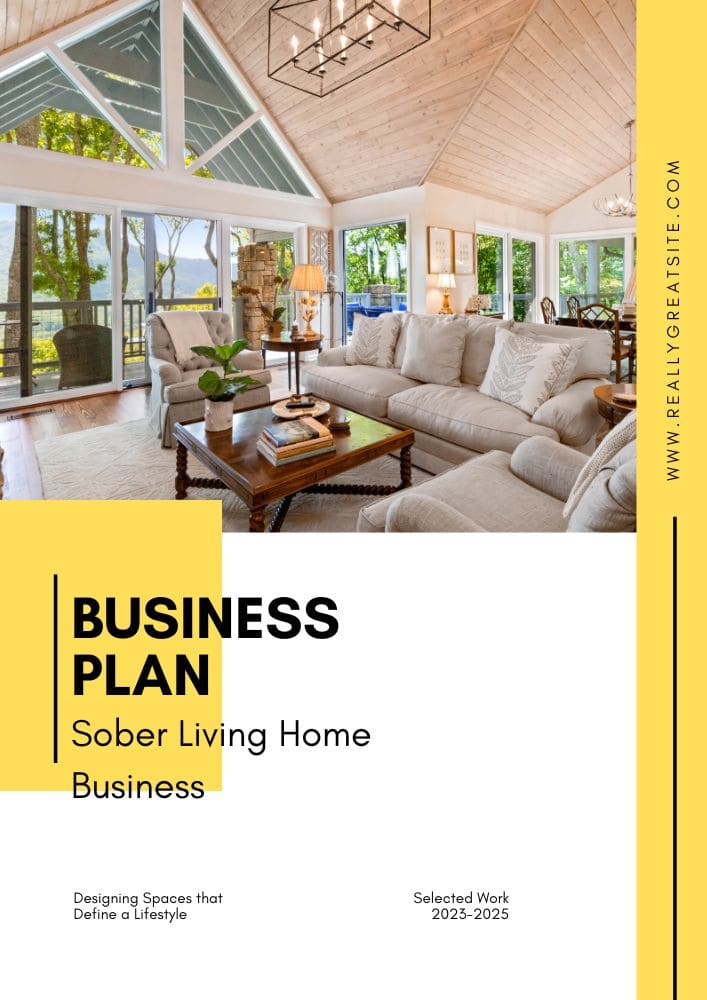Written by Elma Steven | Updated on April, 2024
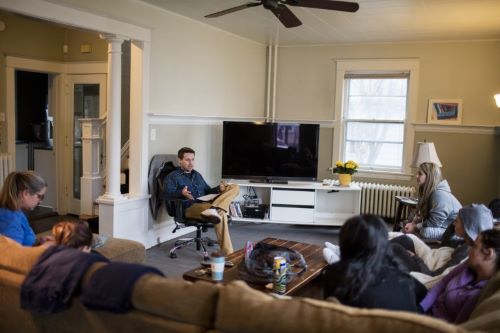
How Do I Write the Sober Living Home Business Plan?
Sober Living Home Business Plan is an outline of your overall sober living home business. The home business plan should includes a 5 year financial projection, marketing plan, industry analysis, organizational overview, operational overview and finally an executive summary. Remember to write your executive summary at the end as it is considered as a snapshot of the overall business plan. You need to be careful while writing the plan as you need to consider various factors that can impact the business’s success. Read the sample sober living home business plan in order to have a clear understanding on the process.
Table of Contents
Executive Summary
David Torres’ Serenity Path Sober Living is a shining example of a successful sober community in Miami. This center provides a safe, encouraging and organized setting for those working through the process of addiction rehabilitation. David Torres who has worked in the field of addiction and recovery programs for over fifteen years is the team leader of a group of compassionate and knowledgeable experts that are committed to helping locals maintain their sobriety. Serenity Path’s USP is its personalized treatment plans, intensive training in life skills, community integration programs and priority placed on both mental and physical well-being. The building was built with the occupants’ sense of community, responsibility and development in mind.
Mission: Peaceful Way By providing a safe and supportive community that prioritizes sobriety and personal development, Sober Living is committed to bolstering the independence of people in recovery. Our emphasis is on developing a supportive community that supports in rebuilding lives and fostering confidence for a successful reintegration into society.
Vision: Our purpose is to set the standard for sober living in Miami by providing our residents with the highest quality of care. Enabling people to lead successful lives post-recovery, having a lasting beneficial effect on the community.
Industry Overview:
The rising rate of substance use disorders (SUDs) in the United States has fueled the expansion of the sober living home sector of the healthcare business. NIDA reports that over 20% of American people experienced a substance use disorder (SUD) in the previous year, with 2% suffering from a severe case. To stay sober and achieve long-term recovery these people typically need help beyond what is offered in conventional treatment facilities. Check out this guide on how to write an executive summary? If you don’t have the time to write on then you can use this custom Executive Summary Writer to save Hrs. of your precious time.
Financial Highlights
Revenue & Earnings

Cost of Goods Sold & Expenses

Break- Even Analysis

Investments or Fund Usage Plan

Business Description
Business Name: Serenity Path Sober Living
Founders: David Torres
Management Team:

Legal Structure: LLC
Location: Miami
Goals & Objectives:
✔️Financial Stability and Growth: Regaining financial stability is an important part of the sober life process. Profitability can only be guaranteed if operational costs are managed effectively. Adding new service locations and upgrading existing ones in the Miami area are part of the company’s long-term financial goal.
✔️Community Engagement and Partnerships: To forge strong relationships to the local community to form cooperation with local health organizations, hospitals and rehabilitation groups. Serenity Path can better serve its community by becoming part of Miami’s larger system of recovery and wellness programs.
✔️Service Quality and Innovation: The company has set quality service delivery and innovation in recovery and wellness as two of its primary objectives. Staff members should get ongoing education effective rehabilitation programs should be put into place and novel approaches to health and wellbeing should be implemented. Maintaining the facility’s status as a premier sober living home depends on its keeping abreast of developments in the fields of addiction recovery and mental health.
✔️Resident Success and Aftercare: The long-term success of residents in sustaining sobriety and reintegrating into society after treatment is essential. One approach to do this is via the establishment of all-encompassing aftercare programs the development of a robust alumni network and the provision of continuous support. Monitoring the long-term results of previous residents may also give helpful suggestions for enhancing the program.
✔️Sustainability and Social Responsibility: Eco-friendly facility management, volunteering and raising public awareness about addiction and rehabilitation are all examples of what this phrase may mean.
Services:
✔️Structured Sober Living Accommodations: The primary benefit is a stable place to stay for those working on their sobriety. This comprises suitable living quarters, common places for social interaction and a substance-free atmosphere. The housing would be intended to generate a feeling of community and responsibility among members.
✔️Individualized Recovery Planning: Each participant gets a unique treatment plan suited to their individual requirements and objectives. This plan would target many elements of their rehabilitation including physical health, emotional wellbeing and personal development objectives.
✔️Professional Counseling and Therapy: Individual treatment, group therapy and specialty sessions like cognitive-behavioral therapy (CBT) or trauma-informed therapy provided by trained professionals. Addiction treatment and mental health promotion programs like these are essential.
✔️Life Skills Training: Life skills training programs provide people with the tools they need to become self-sufficient and productive members of society. This include the ability to manage one’s finances, to organize one’s time and to read and write.
✔️Health and Wellness Programs: Yoga, meditation, exercise programs and dietary advice are just some of the services you’ll find here. These initiatives are geared on bettering participants’ health and happiness generally.
Business Model Canvas
The Business Model Canvas is a high-level overview of the business model. It can also be considered as the business model map in the overall plan. A company idea’s complexities may be mapped out, analyzed and communicated with the use of the canvas. It shows the whole picture of a company’s value creation, delivery, and capture processes. It helps new business owners hone their ideas, encourage creative thinking and make sound strategic decisions. It’s a helpful resource for coming up with ideas, organizing plans and presenting business models to key players. Check out 100 samples of business model canvas.

SWOT
It offers a clear lens into a company’s strengths, weaknesses, opportunities, and threats. This self-awareness enables effective resource allocation and strategic positioning against competitors. Businesses can mitigate risks, make informed decisions, and set realistic goals. In addition, presenting a SWOT analysis in a business plan communicates to stakeholders that the company possesses a deep understanding of its market environment. In essence, SWOT ensures a business’s strategy is grounded in reality enhancing its chances of success. Check out the 100 SWOT samples which will give you a better idea on SWOT writing process.

Marketing Plan
The marketing plan has five main sections. These sections are marketing budget, marketing channels, GTM or Go To Market Strategy and brand management. The marketing budget will explain how much you plan to spend on promotions and what will be the proportion of spending across the channels. The marketing channels section will talk about how you plan to use each of the promotional channels. The GTM strategy can be considered as the short term version of promotional channels section where you explain how you plan to penetrate the market using the channels at the beginning. Finally, brand management is the longer term version of the promotional channels section where you explain how you plan to enhance brand awareness, recognition and brand recalls amongst your target market.
Promotional Channels
Community Outreach and Partnerships (30% – $15,000)
✔️Local Health Facilities and Rehab Centers: Building relationships with local health facilities, hospitals and rehab centers for referrals.
✔️Community Events: Promoting sobriety and rehabilitation from substance abuse by appearing in community health fairs, workshops and speaking engagements.
Digital Marketing and Social Media (20% – $10,000)
✔️Website Development and Blogging: A clean, well-written blog on health, wellbeing and staying sober in today’s world.
✔️Social Media Engagement: Getting the word out, telling success stories and offering useful tools via social media sites like Facebook and LinkedIn.
Educational and Awareness Programs (10% – $5,000)
✔️Workshops and Seminars: Putting on or supporting activities that teach people about staying clean and healthy after addiction.
✔️Collaborations with Educational Institutions: Partnering with local schools and universities to offer talks and support programs.
Referral Programs (14% – $7,000)
✔️Incentivizing Referrals: Offering incentives to present residents, previous residents, healthcare professionals and local businesses for introducing new residents.
✔️Alumni Networks: Alumni activities aimed at re-engaging previous residents and inspiring them to spread the word.
Content Marketing and SEO (12% – $6,000)
✔️SEO Optimization: Making sure the website is search engine friendly in order to increase its organic visitor numbers.
✔️Content Marketing: Producing excellent material that covers subjects relating to recovery, health and sober living.
Local Advertising and Direct Outreach (8% – $4,000)
✔️Local Media Advertising: Utilizing local newspapers, radio stations and community newsletters for advertising.
✔️Direct Mail: Sending informational brochures or flyers to local businesses, healthcare facilities and community centers.
Email Marketing and Newsletters (6% – $3,000)
✔️Regular Newsletters: Sending out newsletters to subscribers with updates, success stories and resources related to sober living and recovery.
✔️Email Campaigns: Targeted email marketing to healthcare practitioners, local companies and community groups to tell them about the facility and its offerings.
Brand Management
Social Media Marketing
✔️Website and SEO: Create website that is simple to navigate and clear description of your business’s resources and achievements. Increase your site exposure in search engine by optimizing it for terms like sober living, recovery homes and addiction recovery support.
✔️Social Media Engagement: Create a helpful online group by using sites like Facebook and Instagram. Share success stories, motivating articles and facts on addiction treatment and sober life.
Content Marketing
✔️Educational Blogging: Create content for your blog that discusses the process of becoming clean how to stay sober and the value of sober communities.
✔️Video Testimonials: In order to convince potential clients that your facility is the right choice show them video testimonials from former residents who have adjusted well to independent sobriety.
Community Engagement
✔️Partnerships with Local Health Organizations: Collaborate with local health clinics, hospitals and rehab centers for referrals and joint wellness programs.
✔️Community Outreach Programs: Get your name out there by hosting and attending health and wellness activities in the neighborhood.
Email Marketing
✔️Newsletters: A consistent email that keeps people in the know about meetings, successes and sobriety maintenance advice.
✔️Resource Sharing: Provide valuable resources and articles related to addiction recovery and wellness.
Local SEO and SEM
✔️Google My Business: Keep your profile up-to-date with photographs, contact details and the services you provide to rank higher in local search results.
✔️Ad Campaigns: Run customized marketing campaigns promoting the unique qualities of your sober living facility such as specialized programs, facilities or experienced staff.
Go To Market Strategy
Community Outreach and Public Relations
✔️Brand Messaging: Your voice which is both sympathetic and authoritative is essential. Attracting those who are in need of help requires conveying messages of hope and healing.
✔️Public Relations: Working with regional media to publicize success stories helps reduce the stigma associated with addiction and highlight the value of your program’s offerings.
Digital Marketing and Online Presence
✔️Brand Messaging: Your voice which is both sympathetic and authoritative is essential. Attracting those who are in need of help requires conveying messages of hope and healing.
✔️Public Relations: Collaborating with local media to feature recovery stories not only raises awareness but also helps in destigmatizing addiction and promoting the effectiveness of your services.
Email Marketing and Newsletters
✔️Newsletter Content: Sharing inspiring tales and updates on a regular basis will help you stay connected to your audience.
✔️Segmentation: Communicating effectively requires that you modify your topic based on who you’re talking to.
Local Partnerships and Networking
✔️Healthcare Partnerships: A referral network and reputation may be established via strategic partnerships with local health authorities.
✔️Community Events: Being visible and showing your dedication to community health may be accomplished by active involvement in local activities.
Content Marketing and Blogging
✔️Educational Blog Posts: Focusing on relevant topics can position your facility as a thought leader in the sober living and recovery field.
✔️Guest Blogging: This may help you reach a larger audience and promote awareness of your offerings.
Organizational Overview
The organizational overview section summarizes the company’s structure and operations. It explains the organizational structure including the hierarchy of reporting relationships, ownership and responsibilities of key management personnel. This also explains how the founder’s past experiences and credentials can help make the business successful.
Founder

David Torres is the man behind Miami’s newest sober living facility that has a rare blend of first-hand knowledge, compassion and dedication to the recovery process. His personal walk to recovery has been the motivating factor behind his ambition to offer a caring and loving atmosphere for individuals seeking a life free from addiction.
Beginning with his personal experiences with addiction and recovery David set out on his quest. Having been through it himself he now has a deep appreciation for the struggles his fellow recovering addicts confront. He is uniquely prepared to help others since his compassionate approach stems from his own personal journey.
David has taken what he has learned from his personal sobriety and from his studies in addiction counseling and therapy and created a holistic strategy for staying clean. His goals go beyond just making sure the place is drug-free and secure he also wants to help people develop as individuals, strengthen their resolve and bond with one another.
Positions and Responsibilities
Chief Executive Officer (CEO) – David Torres:
David Torres oversees the long-term goals and operational strategy of the facility for recovering addicts. His responsibilities include strategic planning, goal-setting, community engagement and promotion of enhanced addiction rehabilitation tools. As the top decision-maker, he guarantees that the institution is operating in accordance with its stated goals and principles.
Operations Manager:
You’ll be responsible for managing the sober living facility on a daily basis. Staff management, regulatory compliance and upholding rigorous care standards are within your purview. The Operations Manager is crucial in providing a secure, helpful and productive setting for the residents.
Resident Coordinator
The Resident Coordinator oversees the admissions process, plans the residents’ stays and makes sure they have everything they need. You will be responsible for keeping a close eye on the residents’ development and guiding them as necessary.
Addiction Counselor/Therapist:
Individual and group therapy, counseling and the creation of individualized treatment programs are just some of the crucial support services provided by these experts to the residents. Helping addicts deal with the mental and emotional challenges they face throughout rehabilitation.
Peer Support Specialist:
Peer support specialists provide residents with advice, encouragement and mentoring based on their own experiences in the recovery process. They’re essential to creating a warm and accepting atmosphere at home.
Organogram
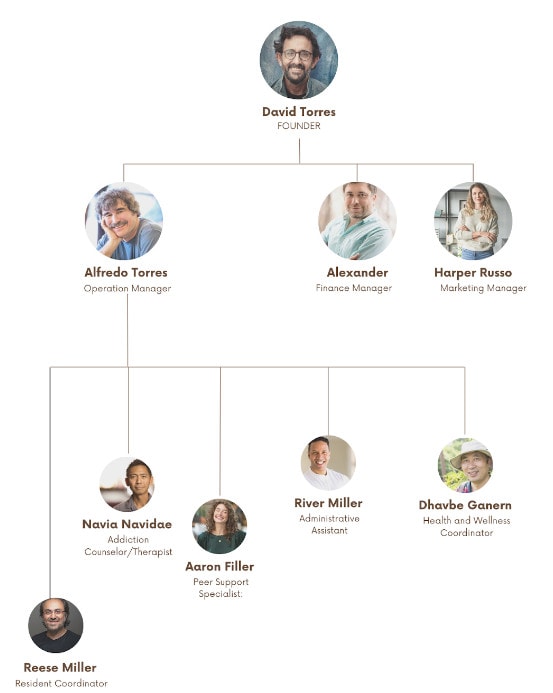
Operational Overview
Services
Structured Sober Living Environment:
✔️A safe, supportive and drug-free living space conducive to recovery.
✔️Structured daily routines to help residents develop healthy habits and life skills.
Individual and Group Therapy Sessions:
✔️Regular individual therapy sessions with qualified counselors and therapists.
✔️Peer support and the sharing of recovery experiences are bolstered in group therapy sessions.
12-Step and Alternative Recovery Programs:
✔️Provision for both conventional 12-step and non-traditional recovery methods.
✔️Customized recovery plans to suit individual beliefs and preferences.
Life Skills Training and Workshops:
✔️Workshops focusing on essential life skills like financial management, job readiness and healthy living.
✔️Classes designed to assist people effectively reenter society after being away.
Recreational and Wellness Activities
✔️Activities planned to improve both physical and mental wellbeing.
✔️Wellness programs including yoga, meditation and fitness classes.
Industry Analysis
Source: openpr
Rising rates of substance abuse and the need for more effective treatment have created a dynamic market for sober living facilities. Projected to expand at a CAGR of 7.1% in the United States and 5.8% worldwide over the next several years.
There are over 150,000 individuals in Miami alone who might benefit from substance abuse rehabilitation making the sober living business in the United States worth over $35 billion annually. There has been a 20% increase in the number of sober living homes in the United States over the previous five years and the typical length of time spent in such a home is six months.
Globally the sober living industry is projected to be valued over $100 billion each year. The rising number of persons with SUD is a major factor in this expansion in 2019 it is predicted that 266 million people throughout the globe will engage in illicit drug use.
Source: zipdo
Other Sober Living Industry Statistics:
✔️The average length of stay in a sober living facility in the United States is six months.
✔️The cost of operating a sober living facility in the United States is between $30,000 and $50,000 per year.
✔️The number of sober living facilities in the United States has grown by 20% in the past five years.
✔️There are an estimated 150,000 adults in Miami who need treatment for SUD.
Source: echorecovery
Industry Problems
✔️Adjustment to Structured Living: Residents may have difficulty adjusting to the rules and procedures of a sober living community at first particularly if they are coming from a less regimented living situation.
✔️Relapse Triggers: Residents’ sobriety may be seriously threatened by exposure to circumstances, pressures or emotional states that elicit cravings or thoughts of relapse.
✔️Interpersonal Conflicts: Living in a shared space with other people who are also in the process of recovering from addiction may lead to interpersonal issues which if not handled properly can create a stressful situation.
✔️Financial Strain: While a sober living environment is essential for a successful recovery it may be expensive for some tenants to maintain particularly if they are still looking for work.
✔️Mental Health Issues: Residents with co-occurring mental health disorders may face additional challenges in managing their mental health alongside their recovery from addiction.
Industry Opportunities
✔️Personalized Adjustment Programs: Create tailored plans to ease each client’s entry into the sober living home’s regimented lifestyle. Tailored orientation sessions may aid this transition.
✔️Comprehensive Relapse Prevention Plans: Create effective programs for preventing recurrence such as one-on-one therapy, group therapy and coping skills training. Holding courses on coping with triggers on a regular basis might be helpful.
✔️Conflict Resolution Training: Offer conflict resolution training and mediation services to help residents navigate interpersonal conflicts. This could include communication workshops and regular community meetings.
✔️Financial Assistance and Planning: Help those in your community who are struggling financially by offering them access to credit counseling, job search aid and potentially a sliding scale cost structure.
✔️Integrated Mental Health Support: Partner with mental health providers to offer integrated assistance for residents with co-occurring illnesses. Access to mental health care including regular tests and treatment might be critical.
Target Market Segmentation
Geographic Segmentation
✔️Miami-Dade County Residents: Pay special attention to those who live in the county and are interested in sober housing in the area. Among these steps is contacting hospitals and rehabilitation facilities in the area to get patient referrals.
✔️Specific Miami Neighborhoods: Focus on areas that may have a larger need for sober living homes or are currently neglected by the industry. It might be helpful to work together with community hubs and medical facilities in these locations.
Demographic Segmentation
✔️Age Groups: Services should be tailored to various age groups. Younger individuals may need different assistance and programs compared to older ones in recovery.
✔️Cultural Diversity: Embrace Miami’s diverse population by offering culturally sensitive programs and employing staff who can speak multiple languages and understand different cultural backgrounds.
Psychographic Segmentation
✔️Individuals in Early Recovery: Prioritize those who are just starting out on the road to recovery by providing extensive resources such as support groups and educational opportunities.
✔️Long-term Recovery Residents: Supported independent living is an option for those who have made significant progress in their rehabilitation and are ready to take the next step toward more autonomy.
✔️Family-focused Individuals: Offer programs that include family counseling and support targeting residents who are keen on rebuilding family relationships as part of their recovery.
Behavioral Segmentation
✔️Residents Seeking Comprehensive Support: Target people who have several needs such as therapy life skills training and employment assistance.
✔️Residents Looking for Community Engagement: Target individuals who are interested in community involvement and volunteer opportunities as part of their recovery process.
✔️Post-Treatment Transitional Residents: Care for those who have recently left an inpatient treatment facility and need use some help readjusting to life on their own.
✔️Artists Seeking Traditional Analog Experiences: Some artists prefer the warmth of analog recordings. Providing access to vintage equipment and analog recording techniques can attract this niche.
Market Size
✔️Total Addressable Market (TAM) for Recording Studio: Your sober living facility’s TAM includes the whole US market for rehab and sober living. Everyone from those leaving inpatient treatment facilities or outpatient programs to those looking for a sober living environment is included here. The prevalence of drug use disorders, the accessibility of treatment facilities and the rising recognition and acceptance of sober living as an essential component of the recovery process all have a role in shaping TAM. Sober living facilities have a great chance to expand in the TAM because of the growing interest in mental health and addiction treatment.
✔️Serviceable Addressable Market (SAM) for Recording Studio: Your sober living facility may reasonably expect to serve is reflected in the SAM. This depends on your geographical area (Miami-Dade County), the kind of rehabilitation services you provide and the types of people you’re trying to help (those of a certain age or economic bracket, for example). For instance, if your home caters to a specialized population (say, young people) or employs unconventional rehabilitation methods (holistic approaches, vocational training), your SAM will be different from a facility that serves a more general population.
✔️Serviceable Obtainable Market (SOM) for Recording Studio: Your sober living facility may reasonably hope to catch the SOM of the SAM. This is the portion of the market that you can realistically capture given your existing strengths and standing. Your SOM is impacted by a number of factors including your facility’s reputation, the quality and breadth of your recovery support programs, the experience of your personnel and the success of your outreach and marketing initiatives. Using the SOM as a guide, you may set reasonable goals for your company’s occupancy rates and service consumption, which will help direct your operational and strategic choices.
Industry Forces
Market Demand and Recovery Trends
Greater public interest in substance abuse rehabilitation and mental health services drives the need for sober living facilities in Miami. There is a rising demand for facilities that offer a supportive living environment after rehabilitation, especially as more attention is paid to holistic and long-term healing techniques. Sober living facilities that provide all-around care are becoming more important as the trend toward combining mental health and addiction treatment gains momentum. Your facility will be better able to serve the changing requirements of people in recovery if its offerings are in line with these developments.
Competition
Other local facilities, rehabilitation clinics providing transitional living choices and at-home recovery programs also compete with sober living homes. Differentiating your residence from the competition requires offering unique services, outstanding support and seamless community integration in today’s housing market. Attracting residents who want a personalized rehabilitation experience may be aided by emphasizing your home’s distinctive features in such as programs customized to certain demographics or alternative wellness options.
Regulatory Environment
Compliance with regulatory requirements, including health and safety regulations, privacy laws and zoning ordinances, is necessary for the operation of your sober living home. The services you provide and the way you handle resident data may be significantly impacted by your level of knowledge of healthcare policy and addiction rehabilitation standards as they evolve. To run legally and keep one’s good name, one must tread carefully across these legal minefields.
Economic Factors
The demand for sober living homes is affected by the economy and more specifically by the financial circumstances of those who are in need of rehabilitation services. The capacity of prospective residents to purchase recovery services may be influenced by economic fluctuations such as recessions or boom times. If you are aware of these economic variables, you may modify your company strategy to better serve inhabitants from a variety of backgrounds such as by providing a sliding scale for prices or establishing a scholarship fund.
Social and Community Engagement
Increasing your sober living facility’s attractiveness by implementing community service and social programs. Your facility’s reputation will improve and residents who value community participation will move in if you work with local recovery organizations, conduct community activities and participate in public health programs. Additionally, establishing a socially responsible image might appeal to a larger population, especially those who appreciate community-centered treatment techniques.
Financial Statements
The financial model has all the important financial statements including Income Statement, Balance Sheet and Cash Flow Statement. In addition, the financial model includes 3 to 5 years of projections and can be edited using Microsoft Excel or Google Sheets.
Income Statement
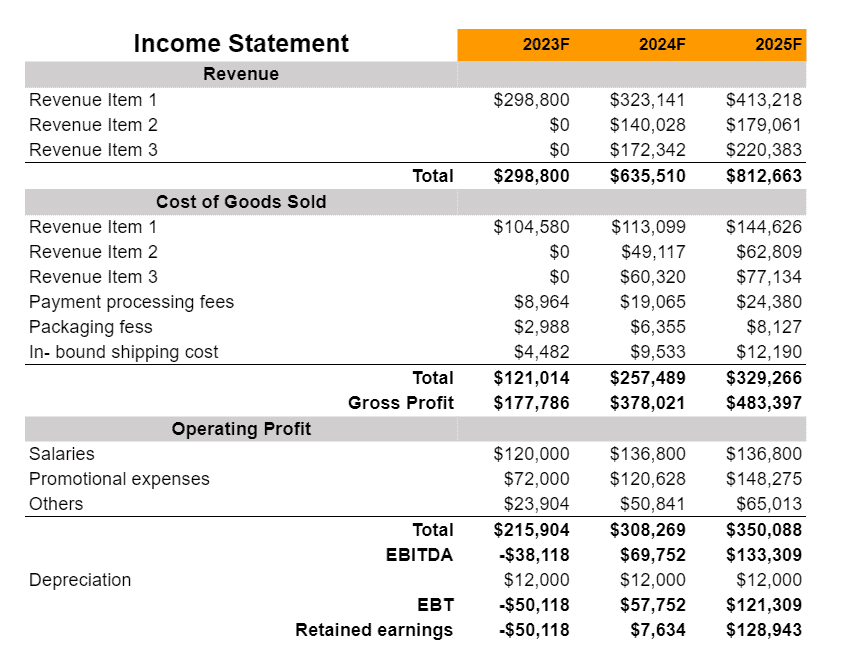
Cash Flow Statement
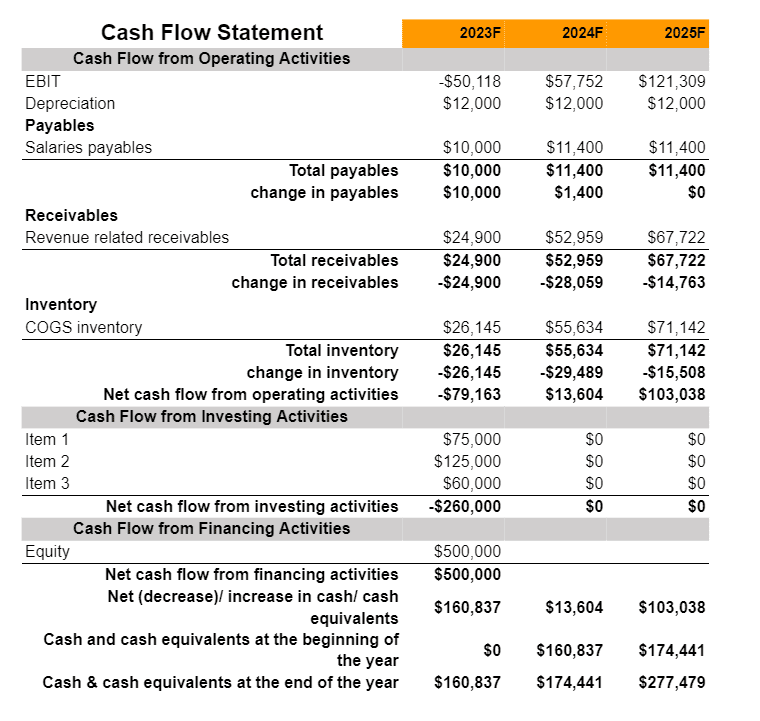
Balance Sheet
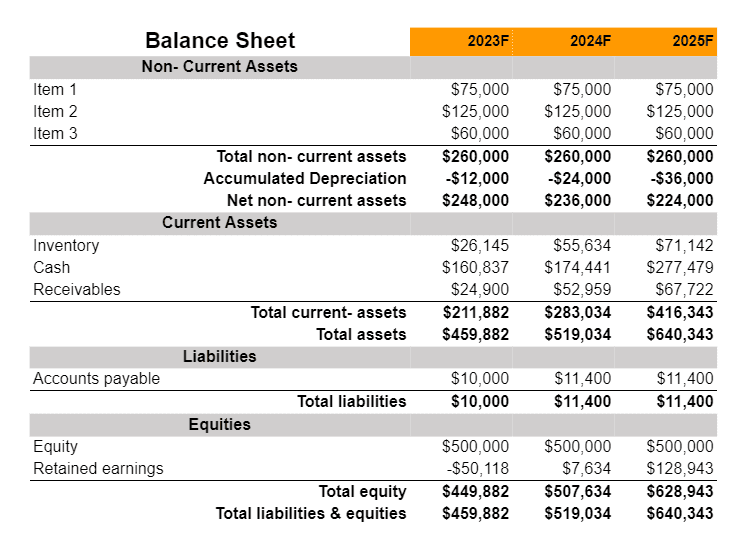
Revenue Summary
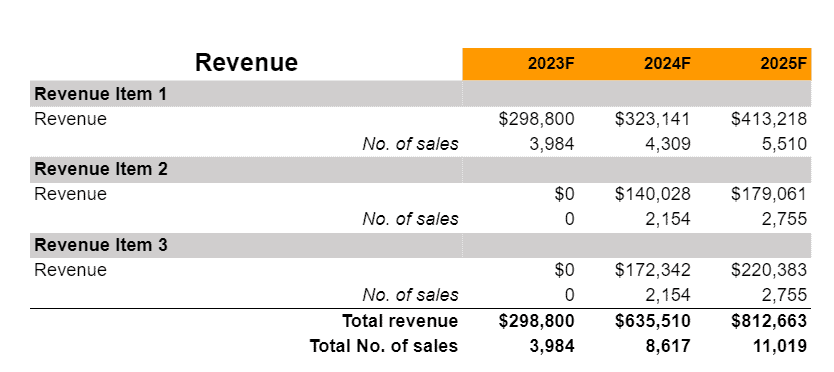
Cost of Goods Sold
